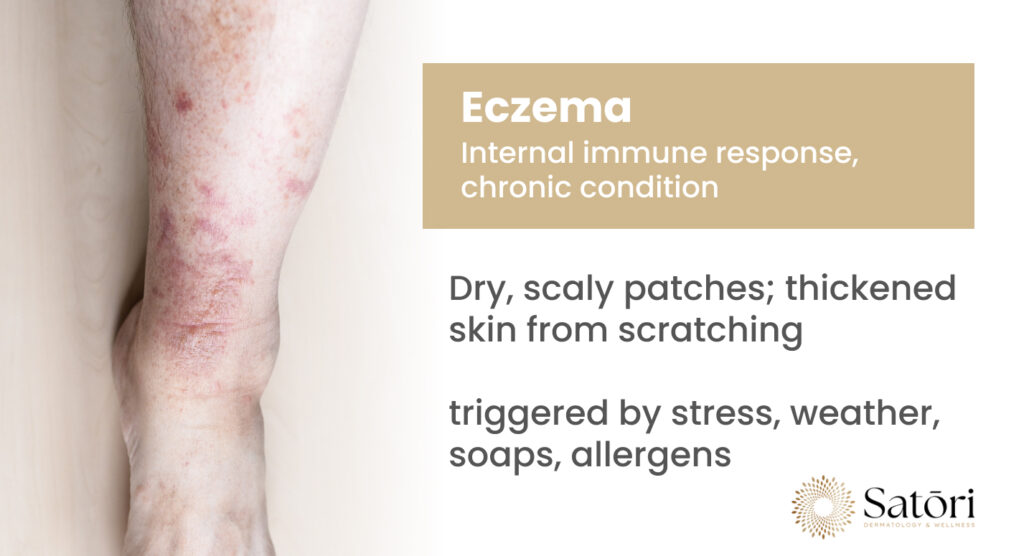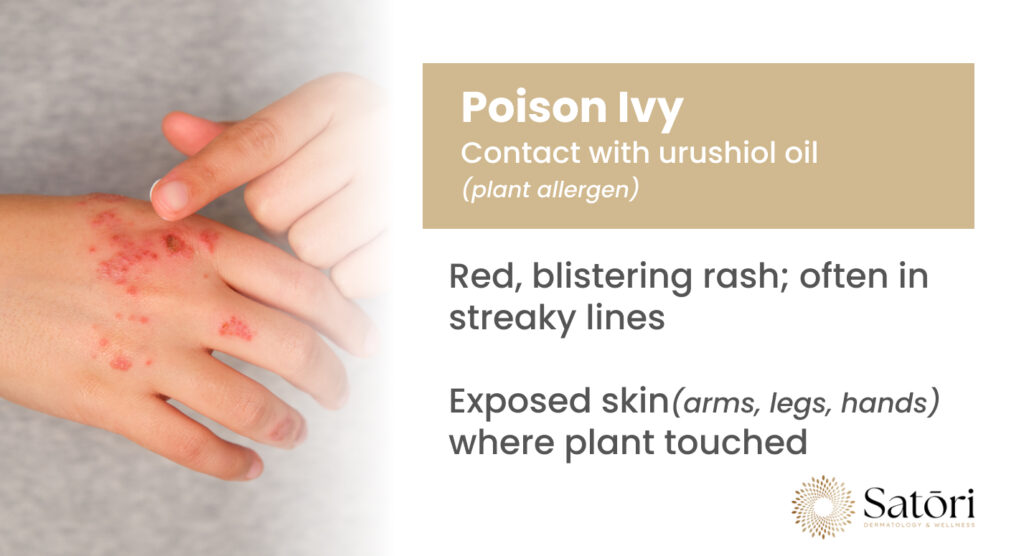When your skin erupts in angry red bumps and unbearable itching takes over, identifying the culprit becomes crucial for proper treatment. Two of the most commonly confused skin conditions—eczema and poison ivy—can leave you scratching your head (and unfortunately, your skin) trying to figure out what’s causing your discomfort.
While both conditions share similar symptoms like redness, inflammation, and that maddening urge to scratch, understanding their differences can mean the difference between quick relief and prolonged suffering. Let’s dive into everything you need to know about these troublesome skin conditions.

Understanding Eczema as a Chronic Skin Companion
Eczema, medically known as atopic dermatitis, is a chronic inflammatory skin condition that affects millions of people worldwide. Unlike poison ivy, eczema isn’t caused by external contact with an irritant—it’s an internal immune system response that manifests on your skin.
This persistent skin condition typically appears as dry, scaly patches that can become intensely itchy. The affected areas often develop a characteristic rough texture, and constant scratching can lead to thickened, leathery skin over time. Eczema commonly appears on the hands, feet, ankles, wrists, neck, upper chest, eyelids, and in the bends of elbows and knees.
What makes eczema particularly challenging is its chronic nature. Flare-ups can be triggered by stress, weather changes, certain fabrics, harsh soaps, or allergens in your environment. The condition often runs in families and is frequently associated with asthma and allergies, forming what doctors call the “atopic triad.”

Poison Ivy as Nature’s Unwelcome Gift
Poison ivy, along with its cousins poison oak and poison sumac, causes allergic contact dermatitis—a reaction that occurs when your skin comes into direct contact with the plant’s oily resin called urushiol. This sticky substance is incredibly potent; even tiny amounts can trigger a significant reaction.
The classic poison ivy rash typically develops 12 to 48 hours after exposure. It starts as redness and swelling, quickly progressing to itchy bumps and blisters that may ooze and crust over. The rash often appears in streaky lines where the plant brushes against your skin, creating a telltale pattern that helps distinguish it from other skin conditions.
Unlike eczema, poison ivy is an acute condition. Once the urushiol is washed away and your body processes the allergic reaction, the rash gradually heals without recurring—unless you’re exposed to the plant again.
Key Differences Between These Skin Conditions
The most significant difference between eczema and poison ivy lies in their causes and patterns. Poison ivy results from external contact with a specific allergen, while eczema stems from internal immune system dysfunction.
Location patterns tell a story. Poison ivy typically appears where direct contact occurred—often on exposed areas like arms, legs, and hands, frequently in linear streaks. Eczema, however, has preferred locations: the creases of elbows and knees, hands, neck, and face, appearing in more symmetrical patterns.
Timing is another crucial differentiator. Poison ivy develops rapidly after exposure, peaks within a few days, and resolves within two to three weeks. Eczema is a long-term companion that waxes and wanes over months or years, with flare-ups that can last weeks without proper management.
The appearance also differs subtly. Poison ivy often presents with distinct blisters filled with clear fluid, while eczema typically shows up as dry, scaly patches that may become red and inflamed when irritated.
Surprising Similarities That Make Diagnosis Tricky
Both conditions share frustratingly similar symptoms that can make self-diagnosis challenging. Intense itching tops the list—both eczema and poison ivy can cause that overwhelming urge to scratch that seems impossible to resist.
Redness and inflammation are hallmarks of both conditions. The affected skin becomes visibly irritated, warm to the touch, and angry-looking. Both can also develop secondary complications from excessive scratching, including bacterial infections that require antibiotic treatment.
Swelling is another common feature. Whether it’s the localized puffiness from poison ivy’s allergic reaction or the generalized inflammation from eczema flare-ups, both conditions can cause noticeable skin swelling.
The appearance of red bumps can be nearly identical in both conditions, especially in the early stages. This similarity often leads to misdiagnosis and inappropriate treatment, which is why professional evaluation becomes so important.
Treatment Approaches for Finding Relief
Treatment strategies differ significantly between these conditions, making proper diagnosis essential for effective relief.
For poison ivy, the primary goal is managing the allergic reaction and preventing secondary infection. Cool compresses provide immediate relief, while over-the-counter antihistamines help control itching. Calamine lotion, a time-tested remedy, can dry out blisters and reduce irritation. For severe cases, oral corticosteroids may be necessary to control the inflammatory response.
Eczema treatment focuses on long-term management and prevention of flare-ups. Moisturizing becomes a daily ritual—thick, fragrance-free ointments help repair and maintain the skin barrier. Topical corticosteroids control inflammation during flare-ups, while newer prescription medications like topical calcineurin inhibitors offer steroid-free options for sensitive areas.
Both conditions benefit from avoiding known triggers. For poison ivy, this means learning to identify and avoid the plants. For eczema, it involves identifying personal triggers like certain soaps, fabrics, or environmental factors.
The golden rule for both conditions? Resist scratching. While easier said than done, scratching can worsen both conditions and increase the risk of secondary bacterial infections.
Related Article: Eczema and Psoriasis Management in the Changing Tennessee Seasons

When to See a Dermatologist for Expert Care
A dermatologist brings specialized expertise that can dramatically improve your skin’s health and your quality of life. These skin specialists can accurately differentiate between eczema, poison ivy, and other similar-looking conditions through careful examination and sometimes additional testing.
For poison ivy, a dermatologist can prescribe stronger medications when over-the-counter options aren’t sufficient. They can also identify and treat secondary infections that may develop from scratching, preventing complications that could lead to scarring.
Eczema management particularly benefits from dermatological expertise. A dermatologist can develop a personalized treatment plan that goes beyond basic symptom control, focusing on long-term skin health. They can prescribe advanced treatments like prescription moisturizers, targeted anti-inflammatory medications, or even newer biologic therapies for severe cases.
Professional care becomes essential when symptoms worsen, don’t respond to initial treatment, or significantly impact your daily life. Signs that warrant immediate dermatological attention include spreading rash, signs of infection (pus, increased warmth, red streaking), fever, or symptoms that interfere with sleep or work.
If you’re in the Franklin, TN, area and want to consult a dermatologist, Satori Dermatology & Wellness can help. Contact us today for a consultation.
Your Path to Healthier Skin
Understanding the difference between eczema and poison ivy empowers you to seek appropriate treatment and find faster relief. While poison ivy may be a temporary nuisance that resolves with proper care, eczema requires ongoing management and professional guidance for optimal control.
Remember, your skin is your body’s largest organ and deserves expert care when problems arise. Whether you’re dealing with the acute misery of poison ivy or the chronic challenges of eczema, a dermatologist can provide the specialized knowledge and treatment options you need to get back to comfortable, healthy skin.
Don’t let skin conditions control your life. With proper diagnosis, appropriate treatment, and professional guidance when needed, you can effectively manage both eczema and poison ivy, keeping your skin healthy and comfortable year-round.

